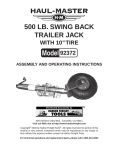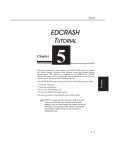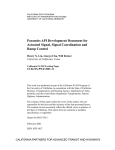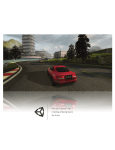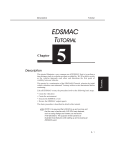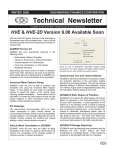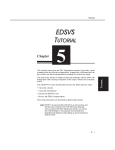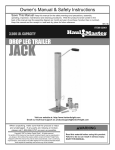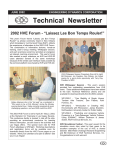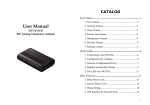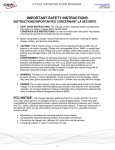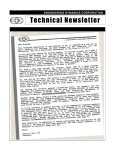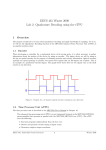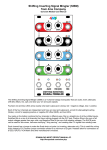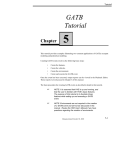Download TUTORIAL
Transcript
Tutorial EDVTS TUTORIAL Chapter 5 We approach the analysis by first determining the CG location of the payload, then estimating the CG elevation of the combined vehicle and payload. This information is critical, because CG elevation is the primary independent variable we wish to hold constant while trying various speeds to estimate the maximum speed at which the offramp can be successfully negotiated. Once this speed is found, we can compare it to the posted off-ramp speed. If the speed is less than the posted speed, we conclude the vehicle was improperly loaded or the posted speed was too high (the latter conclusion would require further supporting analysis); otherwise, we can conclude the driver was speeding; Like all EDVTS events, the procedure involves the following basic steps: • • • • Create the vehicles Create the environment Execute the EDVTS event(s) Review the EDVTS output reports This basic procedure is described in detail in this tutorial. It is assumed that HVE-2D is up and running, and + NOTE: that the user is familiar with HVE-2D’s basic features. The purpose of this tutorial is to illustrate those features while setting up and executing an EDVTS event. 5-1 TUTORIAL This tutorial examines a common use for EDVTS: the simulation analysis of a tractor-trailer off-ramp rollover accident. The purpose of the analysis is to determine if the rollover was the result of excessive speed or an abnormal loading condition (in this case, the payload CG was rather high). EDVTS Getting Started Getting Started As in other tutorials, before we get started with our current tutorial, let’s set the user options so we’re all starting on the same page. In HVE-2D, all options simply affect the appearance + NOTE: in a viewer during Event or Playback mode. in HVE, AutoPosition affects the data used in + However, the analysis. For example, if AutoPosition is On, the vehicle position conforms to the local surface; otherwise, the position is set by the Position/Velocity dialog. Obviously, the resulting difference in initial conditions could substantially change the event. Some of the following options are “Toggles” that + NOTE: switch between two different modes. Make sure these options are set correctly. To set the initial user options, choose the following from the Options Menu: â â â â â â â â â ON: Show Key Results OFF: Show Axes ON: Show Contacts OFF: Show Velocity Vectors ON: Show Skidmarks OFF: Show Targets ON: AutoPosition Units equals U.S. Render Options: • • • • • • • Show Humans as Actual Show Vehicles as Actual Phong Render Method Complexity equals Object Render Quality equals 5 Texture Quality equals 1 Anti-aliasing equals 1 The remaining options will automatically initialize to their default conditions. We’re now ready to proceed with the tutorial. 5-2 Creating the Vehicles Tutorial Creating the Vehicles Now let’s add the vehicles to our case. The tow vehicle is a chrome-yellow Mack truck tractor; the trailer is a 44 foot-long van trailer: â If the Vehicle Editor is not the current editor, choose Vehicle Mode. The Vehicle Editor is displayed. â Click Add New Object. The Vehicle Information dialog is displayed. The Vehicle Information dialog allows the user to select the basic vehicle attributes according to Type, Make, Model, Year and Body Style. The Vehicle Information dialog also allows you to + NOTE: edit the Driver Location, Engine Location, Number of Axles and Drive Axle(s). Our tutorial does not require any of these modifications. Our Vehicle Database does not include a Mack + NOTE: tractor, so we’ll build one from a Generic Class 3 (short wheelbase, tandem axle) truck. A ‘tractor’ is a ‘truck’ with a fifth wheel; there is no + NOTE: need for a separate ‘tractor’ vehicle type. TUTORIAL â Using the option buttons, click each button to choose the following vehicle from the database: • Type = Truck • Make = Generic • Model = Generic • Year = Generic • Body Style = Class 3 The default vehicle name is Generic Class 3. Let’s add something a little more descriptive: â Replace the default name; enter Mack Truck Tractor. â Click OK to add Mack Truck Tractor to the Active Vehicles list. The Mack tractor is displayed in the viewer, as shown in Figure 5-1 on page 5-5. 5-3 EDVTS Creating the Vehicles Next, let’s add the 44 foot semi-trailer. Again, we don’t have the exact vehicle in our database, so we’ll create it, starting with a generic, tandem axle (Class 4) trailer. To create the trailer, perform the following steps: â Click Add New Object. The Vehicle Information dialog is displayed. The Vehicle Information dialog allows the user to select the basic vehicle attributes according to Type, Make, Model, Year and Body Style. â Using the option buttons, click each button to choose the following vehicle from the database: • Type = Trailer • Make = Generic • Model = Generic • Year = Generic • Body Style = Class 4 The default vehicle name is Generic Class 4. Let’s change it: â Replace the default name; enter 44 Ft Semi-trailer. â Click OK to add 44 Ft Semi-trailer to the Active Vehicles list. â The 44 foot semi-trailer is displayed in the viewer, as shown in Figure 5-2. 5-4 Creating the Vehicles Tutorial TUTORIAL Figure 5-1 Mack Truck Tractor, created from a generic Class 3 short wheelbase truck. Figure 5-2 44 Ft Semi-trailer, created from a generic Class 4 Trailer. 5-5 EDVTS Creating the Vehicles Figure 5-3 Vehicle Color dialog, used for assigning the vehicle color. Editing the Vehicles This tutorial includes more vehicle editing than other tutorials, mainly because nearly every on-highway truck is custom built to some degree, and there are so many sizes of trailers. This gives us an opportunity to exercise more features of the Vehicle Editor. Let’s begin by editing the color of the Mack tractor: â Select Mack Tractor from the the Active Vehicles list in the drop-down menu, making it the current vehicle. The Mack Tractor is now displayed in the Vehicle Editor Viewer. â Click on the CG and choose Color. The Vehicle Color dialog is displayed (see Figure 5-3), showing the vehicle’s current color (the small black square, or hot spot, in the color wheel) and intensity (the arrow in the intensity slider). Click on the hot spot and drag it to the outside of the yellow area. To brighten the color, click on the intensity slider and drag it to the far right end of the slider. + NOTE: The color chip on the left shows the current color. â When the color is to your liking, press the Close button to apply the new vehicle color. The vehicle’s apparent color may be slightly + NOTE: misleading because the vehicle is translucent when displayed in the Vehicle Editor. The actual color will be used whenever the vehicle is displayed during Event and Playback mode. 5-6 Creating the Vehicles Tutorial Next, let’s add the 3-D geometry file for the Mack truck. The geometry file was previously digitized by EDC, named TKMackTractor.h3d and placed in the supportFiles/images/vehicles subdirectory. To attach the geometry file to our generic vehicle, perform the following steps: â Click on the CG, choose Exterior Geometry and select Open. The Geometry File Selection dialog is displayed (see Figure 5-4), and we’re ready to select a geometry file from the listbox. â Click on the Files of Type option list and choose HVE Geometry Files (*.h3d). â Scroll down the list and double-click on TKMackTractor.h3d. The new geometry file is applied to the Mack Truck Tractor (see Figure 5-5 on the following page). Next, let’s edit the trailer by changing its color and adding a geometry file. Let’s begin by editing the color of the 44 foot semi-trailer: â Select the 44 Ft Semi-trailer from the Active Vehicles drop-down list, making it the current vehicle. The trailer is now displayed in the Vehicle Editor Viewer. 5-7 TUTORIAL Figure 5-4 Vehicle Geometry File Selection dialog, used for adding a 3-D geometry file to the Mack tractor. EDVTS Creating the Vehicles Figure 5-5 Mack Tractor after adding its geometry file. â Click on the CG and choose Color. The Vehicle Color dialog is displayed (see Figure 5-3), showing the vehicle’s current color (the small black square, or hot spot, in the color wheel) and intensity (the arrow in the intensity slider). Click on the hot spot and drag it to the yellow area near the outside of the color circle. To brighten the color, click on the intensity slider and drag it to the far right end of the slider. + NOTE: The color chip on the left shows the current color. â When the color is to your liking, press OK to apply the new vehicle color. Next, let’s add the 3-D geometry file. A generic 44 foot van trailer geometry file, appropriately named TLGeneric44Van.h3d was prepared by EDC and placed in the supportFiles/images/vehicles subdirectory. To attach the geometry file to the trailer, perform the following steps: â Click on the CG, choose Exterior Geometry and select Open. The Geometry dialog is displayed (see Figure 5-6), and we’re ready to select a geometry file from the listbox. â Scroll down the list and double-click on TLGeneric44Van.h3d. The new geometry file is applied to the generic trailer (see Figure 5-7). The tractor and trailer are now ready for our EDVTS simulation analysis. 5-8 Creating the Vehicles Tutorial TUTORIAL Figure 5-5 Vehicle Geometry File Selection dialog, used for adding a 3-D geometry file to the 44 foot van trailer. Figure 5-6 44 Ft Semi-trailer after adding its geometry file. 5-9 EDVTS Creating the Environment Creating the Environment Now, let’s add the environment: â Choose Environment Mode. The Environment Editor is displayed. â Click on Add New Object. The Environment Information dialog is displayed. â Using the Location Database combo box, choose Denver, Colorado, USA. The latitude (39.45.00N), longitude (105.00.00W) and GMT, hours from the prime meridian (-7.0) are displayed for the selected location. â Enter a name for the environment, Freeway Offramp, Exit 342. â Enter the date and time of the incident we are studying, 10-22-00 and 1045, respectively. â Enter the angle from true north to the earth-fixed X axis in our environment, 0.0 degrees. The Latitude, Longitude, GMT, Date/Time and + NOTE: angle from true north are used to position the sun in the scene. This is, of course, important because the sun is the primary light source for the scene. â To add the environment geometry file to our case, click on Open. The Environment Geometry File Selection dialog is displayed. â Click on the Files of Type option list and choose HVE Geometry Files (*. h3d) . A list of environment geometry files using the .h3d file format is displayed in a list box. â Double-click on EdvtsTutorial_2D.h3d to choose the environment file and remove the dialog. + HVE users should double-click on FreewayOfframp.h3d. â Press OK. The selected environment is added to our case and displayed in the Environment Viewer (see Figures 5-8 and 5-9). Use the viewer thumb wheels to view the scene. 5 - 10 Creating the Environment Tutorial TUTORIAL Figure 5-8 HVE-2D environment used for the EDVTS tutorial. Figure 5-9 HVE environment used for the EDVTS tutorial. 5 - 11 EDVTS Saving the Case Saving the Case Now that we’ve created all the objects (vehicle and environment) for our case, let’s save the case file. â Click on the File menu and choose Save. The Save-as File Selection dialog is displayed. The Save-as dialog is displayed because the + NOTE: case has not been saved previously, so we need to enter a filename. â In the Case Title text field, enter EDVTS Tutorial, Off-ramp Rollover. The Case Title is displayed as a heading on all + NOTE: printed output reports. â Place the mouse cursor in the Filename text field and enter EdvtsTutorial. â Click SAVE. The current case data are saved in the /supportFiles/case subdirectory. Saving the file occasionally is a highly + NOTE: recommended practice. 5 - 12 Creating the Event Tutorial Creating the Event As mentioned at the outset of the tutorial, we are going to simulate a a tractor-trailer offramp accident to determine if the offramp is negotiable at the posted speed. To create the event, perform the following steps: â Choose Event Mode. The Event Editor is displayed. â Click on Add New Object. The Event Information dialog is displayed. â Select Mack Truck Tractor and 44 Ft Semi-trailer from the Active Vehicles list. â Select EDVTS from the Calculation Method options list. â Enter a name for the event, Offramp Rollover. The name of the calculation method will be + NOTE: appended to the event name, thus the complete event name will become “EDVTS, Offramp Rollover.” â Press OK to display the event editor. Now, we’re ready to set up the event. TUTORIAL â Mack Truck Tractor is the only object listed in the Event Humans & Vehicles list box. Choose Set-up from the main menu bar and select Position/Velocity. The Mack tractor and 44 foot semi-trailer are displayed in the environment. The Position/Velocity dialog for the tractor is also displayed. The tractor CG is located above the earth-fixed origin, and the trailer is connected to the tractor with a zero articulation angle. Even though you didn’t select the trailer from the + NOTE: Event Humans and Vehicles list (in fact, it’s not even in the list), the trailer is automatically attached to the tractor and displayed in the Event viewer because the trailer is a “child” vehicle, that is, HVE-2D knows that the trailer’s position is not independent from the tractor; it is attached to it. â Click on the Mack truck’s X-Y manipulator (see Figure 5-10), wait for it to turn bright yellow (indicating it has been selected), and drag it to its initial position, X=280.0 ft, Y=-48.0 ft (for HVE, X=150.0 ft, Y=-48.0 ft). In the Position/Velocity dialog, enter a heading (yaw) angle of 180.0 degrees. 5 - 13 EDVTS Creating the Event Figure 5-10 Vehicle positioning using the Event Editor. The manipulators can be used to drag and drop the vehicle into position. To select the X-Y manipulator, the viewer must be + NOTE: in Pick mode, as indicated by the highlighted arrow in the upper right corner of the viewer (see Figure 5-10). Be sure to keep the mouse button depressed + NOTE: while you drag the manipulators. Adjust the viewer by dollying back (using the Dolly + NOTE: thumb wheel) until you can see the entire intersection. If you can’t position the vehicle at the exact + NOTE: coordinates, simply enter them in the Position/Velocity dialog (in fact, it’s often easier to directly enter the coordinates using the dialog). When entering coordinates using the + NOTE: Position/Velocity dialog, remember to press <Enter> or Apply; otherwise, the values will not be assigned. â Click the Velocity Is Assigned checkbox. Enter the initial total velocity, 55 mph. 5 - 14 Creating the Event Tutorial The vehicles’ initial conditions are now established. Let’s enter the driver controls. We’ll start with the Mack tractor’s steering table. After a little trial and error, we have arrived at a steer table that causes the vehicle to exit from the freeway onto the offramp and begin steering around the curve. To enter the steer angles, perform the following steps: â Click on the Set-up Menu, select Driver Controls. The Driver Controls dialog appears and the Steering Table is displayed. â Click on the Table Is option list and choose the At Steering Wheel option. â Enter the steer angles for the Mack Truck Tractor, as shown in Table 5-1, below: Time (sec) Steer Angle at Steering Wheel (degrees) 0.00 10.0 2.00 10.0 4.00 9.0 5.50 0.0 6.00 180.0 8.00 270.0 TUTORIAL Table 5-1 Steer table entries for the Mack Truck Tractor. Note the simplicity of the steer table. The steering + NOTE: angle changes gradually, just like it does when you are really driving! Complex driver tables containing several rows of slightly-changing steer angles are usually a bad sign. Next we enter the braking table: â Since the Driver Controls dialog is still displayed, simply click on the Brake tab. The Brake Table dialog is displayed. â Click on the Table Is option list and choose the Available Friction option. 5 - 15 EDVTS Creating the Event â Enter the values shown in Table 5-2, below. â Press OK to accept the brake table. Table 5-2 Brake table for Mack Truck Tractor. Percent Available Friction (%/100) Time (sec) Axle 1 Axle 1 Axle 2 Axle 2 Axle 3 Axle 3 Right Left Right Left Right Left 2.00 0.00 0.00 0.00 0.00 0.00 0.00 2.10 0.01 0.01 0.15 0.15 0.15 0.15 5.00 0.01 0.01 0.15 0.15 0.15 0.15 5.10 0.25 0.25 0.25 0.25 0.25 0.25 This table causes the vehicle to begin coasting when the vehicle leaves the freeway at 2 seconds. Moderate braking begins at 5 seconds, just as the vehicle enters the turn. Next, we need to enter the driver controls for the trailer. To perform this operation, we first need to select the trailer: â If necessary, use the Event Viewer thumb wheels or manipulators to adjust the view so the trailer is visible. â Click on the trailer in the Event Viewer. A set of manipulators is displayed at its connection to the tow vehicle, and the Position/Velocity dialog is displayed, as shown in Figure 5-11. To select the vehicle, the viewer must be in Pick + NOTE: mode, as indicated by the highlighted arrow in the upper right corner of the viewer (see Figure 5-11). We can’t select the trailer from the Event Humans + NOTE: & Vehicle list because the trailer is not an independent vehicle; it is a “child” of the Mack Tractor. Therefore, the trailer is not displayed in this list. 5 - 16 Tutorial Figure 5-11 Trailer positioning using the Event Editor. The manipulators are displayed at the connection between the tractor and trailer. The manipulators can be used to drag and drop the vehicle into position. Now, we’re ready to enter the driver controls for the trailer. To enter the brake table, perform the following steps: â Click on the Set-up Menu and select Driver Controls. The Driver Controls dialog appears. â The Brake tab is the only available tab. The Brake Table is displayed. The Steering, Throttle and Gear Selection options + NOTE: are not available in the Driver Controls cascade menu because the default Driver Location option for trailers is ‘None’ (see Vehicle Editor, Vehicle Information dialog). â Click on the Table Is option list and choose the Available Friction option. â Enter the brake table values for the 44 foot semi-trailer, as shown in Table 5-3, on the following page: 5 - 17 TUTORIAL Creating the Event EDVTS Creating the Event Table 5-3 Brake Table for the 44 Ft Semi-trailer. Percent Available Friction (%/100) Time (sec) Axle 1 Right Axle 1 Left Axle 2 Right Axle 2 Left 2.00 0.00 0.00 0.00 0.00 2.10 0.01 0.01 0.01 0.01 5.00 0.01 0.01 0.01 0.01 5.10 0.25 0.25 0.25 0.25 NOTE: The time and brake entries are identical to those + used for the tow vehicle’s rear tandem axles. We’re assuming a pretty good brake system here; if desired, we could delay the time entries for the trailer and modify any specific entries to account for brake-to-brake variability. â Press OK to accept the brake table for the trailer. Now, let’s add the payload to the trailer. â Click on the Set-up menu and choose Payload. The trailer payload dialog is displayed â Click in the Payload Exists check box.. â Highlight the value in the CG Coordinates, z field and enter -30.0 in. Entering -30.0 locates the payload 30 inches + NOTE: above the unoaded trailer CG height. â Highlight the value in the Weight field and enter 40000.0 lb. â Highlight the value in the Rotational Inertia, Yaw field and enter 3360000.0 ls-sec2-in. â Press OK to update the trailer’s payload. Finally, we must adjust the Roll Couple Distribution to reflect the fact that this is a heavy truck. 5 - 18 Creating the Event Tutorial TUTORIAL Figure 5-12 Key Results Variable Selection dialog, used for selecting variables to be displayed in the Key Results window. â Click on the Options menu and choose Calculation Options. The calculation options for t his event are displayed. â In the Roll Couple Distribution field, replace the default value, 0.55, with a more representative value, 0.2. â Press OK to update the calculation options. This event lasts more than 5 seconds. To prevent premature termination, let’s increase the default maximum simulation time. â Click on the Options menu and choose Simulation Controls. The Simulation Controls dialog is displayed. â Edit the Maximum Simulation Time, changing it from 5 to 20 seconds. â Press OK to update the simulation controls. Since our goal for this event is to see if the vehicle rolls over, let’s look at some Key Results during execution: â If Key Results windows are not displayed, choose Show Key Results from the Options menu. 5 - 19 EDVTS Creating the Event â Drag the Key Results windows to a convenient location, where they do not block the view but still allow us access to the viewer thumb wheel controls (in case we want to change the view). â Click on Select Variables in the Mack Truck Tractor Key Results window. The Variable Selection dialog for Mack Truck Tractor is displayed. Let’s add Tire Fz’ to the Mack’s Key Results window: â Choose Tires, Axle 1, Right, Outer from the variable group list. The Variable Selection list for the right front tire is displayed (see Figure 5-14, above). â Select Fz’ from the list. â Choose Tires, Axle 1, Left, Outer from the variable group list. The Variable Selection list for the Left front tire is displayed; select Fz’ from the list. â Repeat the above steps for Mack’s rear tandem axles, choosing Fz’ for Axle 2 and Axle 3. â Press OK to include the new variables in the Key Results dialog. Next, let’s add the vertical tire forces for the trailer: â Click on Select Variables in the 44 Ft Semi-trailer Key Results window. The Variable Selection dialog for 44 Ft Semi-trailer is displayed. Add Tire Fz’ to the trailer’s Key Results window: â Choose Tires, Axle 1, Right, Outer from the cascade menus. The Variable Selection list for the front tandem axle, right side, is displayed; select Fz’ from the list. â Repeat the above steps for the trailer’s remaining tires. â Press OK to display the new variables in the Key Results dialog. Now, we’re ready to execute the event. â Using the Event Controller, click Play to execute the event. Allow the event to run until completion. While the event is executing, watch the current + NOTE: results (especially the Velocity, Acceleration and F z values) in the Key Results windows. 5 - 20 Creating the Event Tutorial The EDVTS event is shown at time, t = 7.16 seconds in Figure 5-15, when the event terminates due to the trailer’s right front wheel lifting. By reviewing the individual wheel vertical wheel + NOTE: loads, Fz, in the Key Results windows, we can see it was the trailer’s right front wheel that lifted, as noted by the negative value for Fz. EDVTS terminated and told HVE-2D to display a + NOTE: message alerting us to the reason for termination (note the message displayed in Figure 5-13). We have now completed the event. 5 - 21 TUTORIAL Figure 5-13 Event Editor executing the EDVTS event. EDVTS Viewing Results Viewing Results Now that we have produced our EDVTS simulation, let’s take a detailed look at the results. The Playback Editor is used for reviewing and printing reports for each event in the current case, as well as for producing video output. EDVTS produces the following reports: • Accident History - A table of initial and final positions and velocities • Messages - A list of messages produced by the current run • Program Data - A table containing program control information • Trajectory Simulation - A visualization of the event, displayed at a user-selectable time interval • Variable Output - A table containing time-dependent simulation results • Vehicle Data - A series of tables containing the vehicle data used by EDVTS To view the output reports, we need to be in Playback mode: â Choose Playback Mode. The Playback Editor is displayed. 5 - 22 Viewing Results Tutorial Report Windows The reports listed on the previous page are displayed by selecting Report Windows. Each Report Window contains an individual report. TUTORIAL Figure 5-14 Report Window Information dialog, showing the name of the event(s) in the current case. To view the reports produced by the EDVTS, Offramp Rollover event, perform the following steps: â Click Add New Object. The Report Window Information dialog is displayed, as shown in Figure 5-14, and includes a list of the active events (EDVTS, Offramp Rollover is the only event in this file). The Report Window Information dialog also includes the user-editable Report Window Name text field and Select Output option list. â Select EDVTS, Offramp Rollover from the Active Events list. â Click on the Select Output option list and choose any of the available reports. â Press OK to display the report. The selected report will be displayed in a resizable window. The following pages illustrate the reports produced for the EDVTS, Offramp Rollover event. 5 - 23 EDVTS Viewing Results Accident History The Accident History report displays the time and total distance traveled, as well as position and velocity at the start and end of the run. Figure 5-15 Accident History Report for EDVTS, Offramp Rollover. To view the Accident History report for the EDVTS, Offramp Rollover event, perform the following steps: â Click Add New Object. The Report Window Information dialog is displayed. â Select EDVTS, Offramp Rollover from the Active Events list. â Click on the Select Output option list and choose Accident History. â Press OK. The Accident History report is displayed for the EDVTS, Offramp Rollover event, as shown in Figure 5-15. 5 - 24 Viewing Results Tutorial Messages EDVTS produces a number of messages, depending on the outcome of the event. For a complete list and explanation of these messages, see Chapter 6. Figure 5-16 Messages Report for EDVTS, Offramp Rollover. To view the Messages report produced by the EDVTS, Offramp Rollover event, perform the following steps: â Click Add New Object. The Report Window Information TUTORIAL dialog is displayed. â Select EDVTS, Offramp Rollover from the Active Events list. â Click on the Select Output option list and choose Messages. â Press OK. The Messages report is displayed for the EDVTS, Offramp Rollover event, as shown in Figure 5-16. 5 - 25 EDVTS Viewing Results Program Data The Program Data report contains the EDVTS version number and the simulation controls used by the EDVTS event. Figure 5-17 Program Data Report for EDVTS, Offramp Rollover. To view the Program Data report for the EDVTS, Offramp Rollover event, perform the following steps: â Click Add New Object. The Report Window Information dialog is displayed. â Select EDVTS, Offramp Rollover from the Active Events list. â Click on the Select Output option list and choose Program Data. â Press OK. The Program Data report is displayed for the EDVTS, Offramp Rollover event, as shown in Figure 5-17. 5 - 26 Viewing Results Tutorial Vehicle Data TUTORIAL The Vehicle Data report for EDVTS displays vehicle data, tire data and driver control tables for each vehicle in the event. Figure 5-18 Vehicle Data Report for EDVTS, Offramp Rollover. The Vehicle Data report is too large to fit in the + NOTE: viewer. Use the scroll bars to view the entire report. 5 - 27 EDVTS Viewing Results To view the Vehicle Data report for the EDVTS, Offramp Rollover event, perform the following steps: â Click Add New Object. The Report Window Information dialog is displayed. â Select EDVTS, Offramp Rollover from the Active Events list. â Click on the Select Output option list and choose Vehicle Data. â Press OK. A portion of the Vehicle Data report is displayed for EDVTS, Offramp Rollover is shown in Figure 5-18. 5 - 28 Viewing Results Tutorial Variable Output The Variable Output report provides variable values at each timestep in tabular form. It is possible to print these values verses time and export this table as a text file. To view the Variable Output report for the EDVTS, Offramp Rollover event, perform the following steps: â Click Add New Object. The Report Window Information dialog is displayed. â Select EDVTS, Offramp Rollover from the Active Events list. â Click on the Select Output option list and choose Variable Output. â Press OK. The Variable Output report is displayed for the EDVTS, Offramp Rollover event. The table is initially empty, so the next step is to select the time-dependent results we wish to display in the table. Variable Selection â Click on Select Variables in the Variable Output window. The Variable Selection dialog is displayed, allowing us to choose variables to display in the Variable Output table. First, let’s add the velocities and accelerations. These variables belong to the Kinematics output group; this is the default group, and the Kinematics Variables list for the Mack Tractor is already displayed. â Select V-tot, Fwd Acc and Lat Acc from the list. Next, let’s add the vertical wheel loads: â Choose Tires, Axle 1, Right, Outer from the variable groups list. The Variable Selection list for the right front tire is displayed (see Figure 5-19). â Select Fz’ from the list. â Choose Tires, Axle 1, Left, Outer from the variable groups list. The Variable Selection list for the left front tire is displayed; select Fz’ from the list. â Repeat the above steps for Mack’s rear tandem axles, choosing Fz’ for Axle 2 and Axle 3. 5 - 29 TUTORIAL The purpose of our event is to determine the vehicle’s propensity for rollover, so let’s display the velocities, accelerations and vertical tire forces from the Variable Selection dialog. EDVTS Viewing Results Figure 5-19 Variable Selection dialog, used for selecting the results displayed in the Output Report. The above variable list is displayed after selecting the Tires , Axle 1, Right Side, Outer. Next, let’s add the vertical tire forces for the semi-trailer: â Click on the Object Name option list and choose 44 Ft Semi-trailer. The Kinematics Variables list for the semi-trailer is displayed. â Choose Tires, Axle 1, Right, Outer from the variable group list. The Variable Selection list for the front tandem axle, right side, is displayed; select Fz’ from the list. â Repeat the above steps for trailer’s remaining tires. â Press OK. The Variable Output report for the EDVTS, Offramp Rollover event now includes tow vehicle velocity and acceleration and vertical tire loads for each wheel location, as shown in Figure 5-20. 5 - 30 Viewing Results Tutorial TUTORIAL Figure 5-20 Variable Output Report for EDVTS, Offramp Rollover, displaying the selected results. 5 - 31 EDVTS Viewing Results Trajectory Simulation Finally, let’s display a trajectory simulation for this event. To view the Trajectory Simulation for the EDVTS, Offramp Rollover event, perform the following steps: â Click Add New Object. The Report Window Information dialog is displayed. â Select EDVTS, Offramp Rollover from the Active Events list. â Click on the Select Output option list and choose Trajectory Simulation. â Press OK. The Trajectory Simulation viewer is displayed for the EDVTS, Offramp Rollover event (see Figure 5-21). The tractor and trailer are shown at their initial positions. To visualize the motion as the tractor-trailer attempts to negotiate the off-ramp, perform the following steps using the Playback Controller: â Click Play (single right-arrow). The simulation begins and is displayed at the current Playback output interval. â Click Pause. The simulation stops. â Click Reverse (single left-arrow). The simulation plays in reverse. â Click Pause. The simulation stops. â Click Rewind (left arrow with bar). The simulation returns to the start. â Click Advance to End (right arrow with bar) the simulation advances to the end of the run. 5 - 32 Tutorial Figure 5-21 Trajectory Simulation for EDVTS, Offramp Rollover, showing the tractor-trailer at near the end of the run, before the inside trailer wheels lift off the ground. 5 - 33 TUTORIAL Viewing Results EDVTS Viewing Results Printing The final step is to print the above reports. Printing reports is simple. All you do is choose a report and print it. For example: â Click on the dialog header of the Variable Output - EDVTS, Offramp Rollover report. The dialog header is highlighted and the Variable Output window pops to the top of the display (if it isn’t there already), indicating it is the current window. â Click on the File menu and choose Print. The Print dialog is displayed, allowing the user to select from several available print options. Alternatively, you can click on the print icon in the + NOTE: main menu bar. â Press OK. The Variable Output report is printed on the system printer. That’s all there is to it! You can print any other report using the same three steps described above. The Print dialog provides several options. Refer to + NOTE: your printer’s User Manual for more information. For several reports it may be best to print in + NOTE: landscape rather than portrait mode. The font size of both the printed reports and + NOTE: screen display may be edited by clicking on the Options menu and choosing Preferences. Use the Font Size option list to change the size. 5 - 34


































